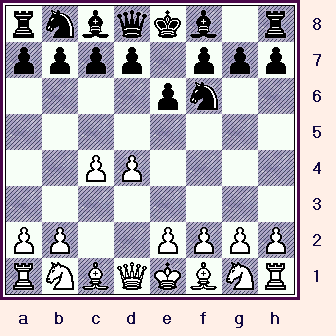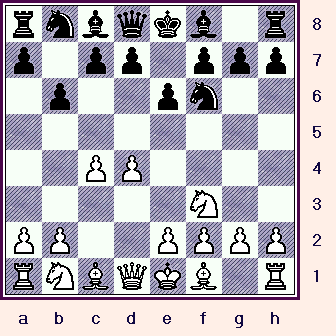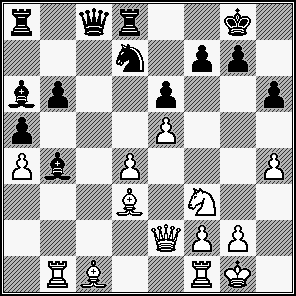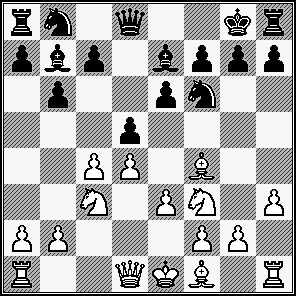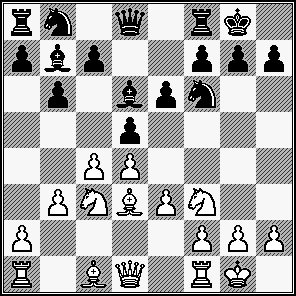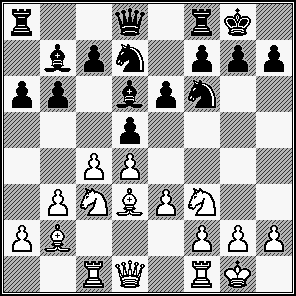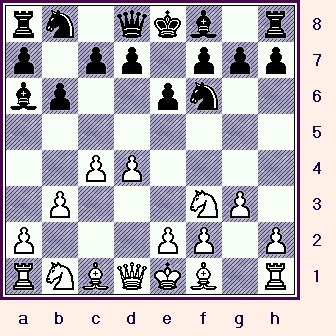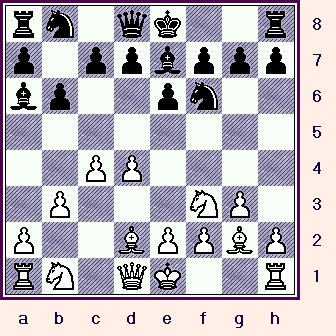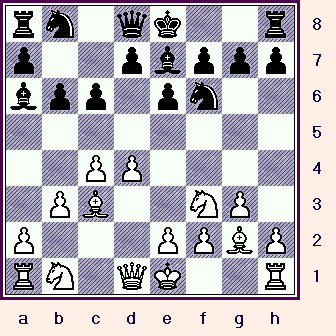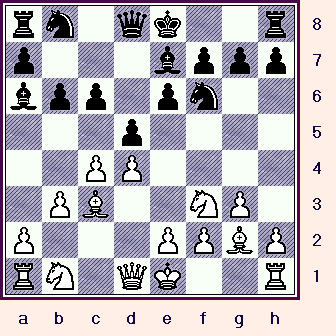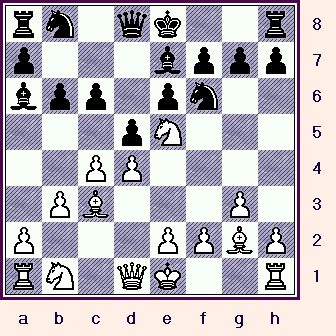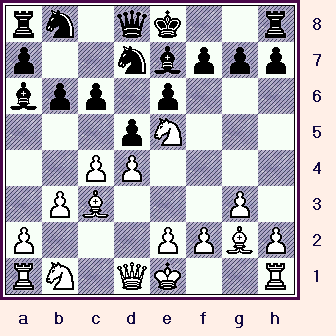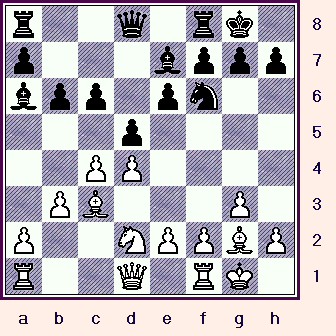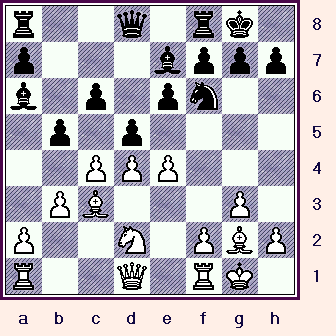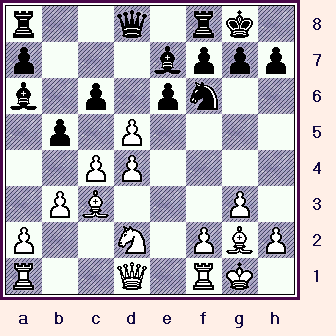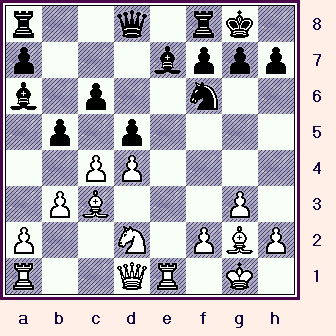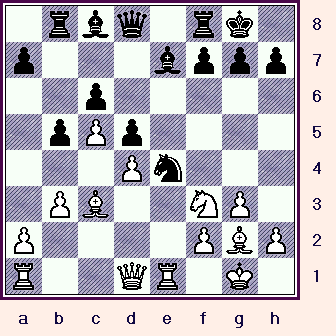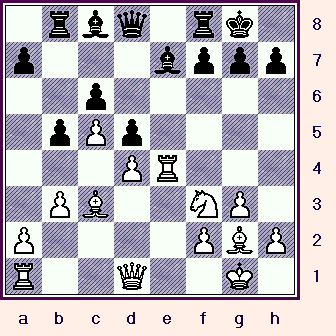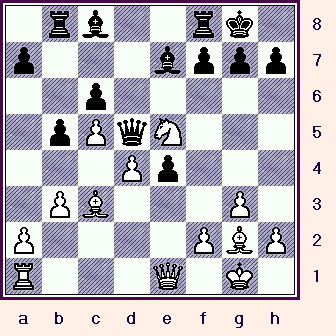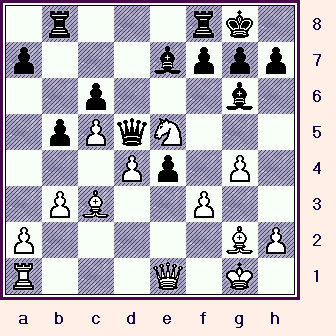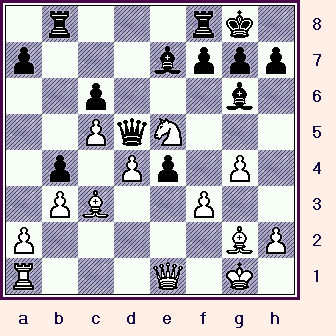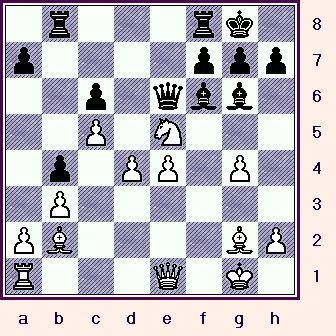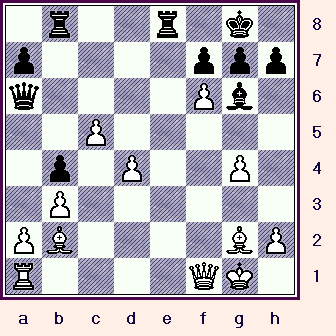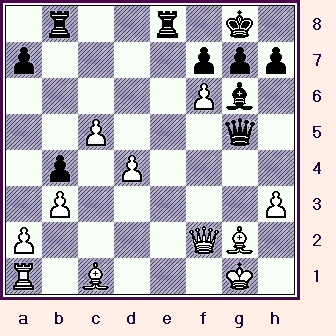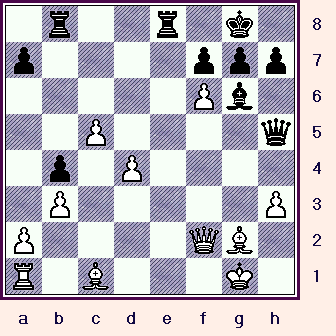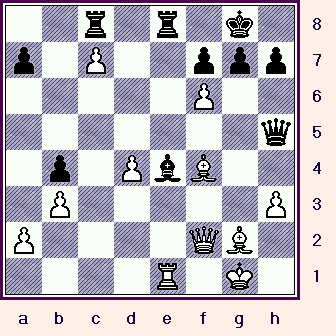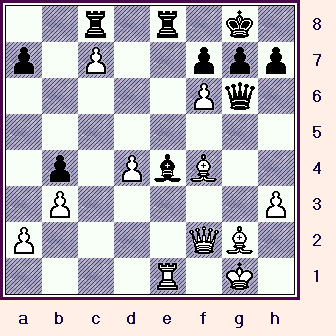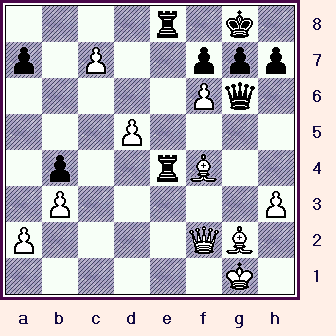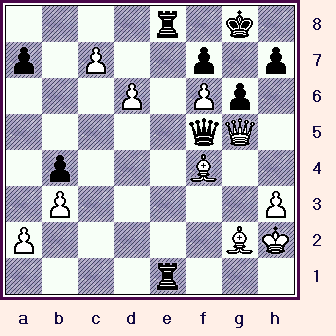GM Veselin Topalov (2801) -
GM Levon Aronian (2752)
|
|
|
My "Game of The Month" for the period for February, 2006. (Cf. TWIC # 586.)
(I also subjected the first few moves to a microscope, and I have tried to - at least briefly - explain each of the first ten plays. This contest will also serve as the next installment of my "opening school" series of annotated games.)
I saw this game shortly after it was played, another master - who watched the whole game online - sent it to me. (I watched some of the early rounds, but I was too busy to watch all of the games.) He told me that, "This is one of the most amazing games that I have ever seen." This opinion has already been echoed by many others; the CB website calls it one of the best games of the year - so far.
Without question it is a great brilliancy, and maybe the best game of the entire CORUS tournament.
** ** ** ** ** ** ** ** ** ** ** ** ** ** ** ** ** ** ** ** ** **
{The ratings are those of FIDE and
were verified by the rating list on the FIDE website.}
1.d4,
This might be the most popular way of beginning a chess game at the GM level today - White grabs space,
hits the center and clears the lines of several pieces. (The WQ and QB.)
1...Nf6; (The more modern method?)
A sensible move, and a very flexible one at that.
(Black controls the center,
hitting e4 and d5, develops a piece and even prepares K-side castling.)
[ The Classical response would be
represented by the move: 1...d5.
(Black controls the center with his
infantry, instead of with pieces.) ]
2.c4,
(center, space)
The sharpest move, and one that
has been played by many GM's in this particular position.
[ With the play: 2.Nf3, "+/=" White plays more cautiously than the actual text move in the game. ]
2...e6; (Conflicting Opening Strategies.) {See the diagram given - just below.}
[ 2...e6; hits d5 and releases Black's Queen and King's Bishop ... so that they too can be developed. ]
*** *** *** *** *** *** *** *** *** *** *** *** *** *** *** *** *** *** ***
A standard, modern opening position has been reached. White controls the center with his Pawns, while Black develops and holds his Pawns back, waiting to see how White will position his forces before committing his pawn skeleton to a set-up that is (more-or-less) permanent.
|
|
rnbqkb1r/pppp1ppp/4pn2/8/2PP4/8/PP2PPPP/RNBQKBNR w
White's development represents the Classical School, whereby those players held fast to the cherished ideal that the only correct way to control the center was by trying to occupy it with the Pawns, (first). Only then - could you develop your pieces ... behind the Pawns for safety. This way of playing the first phase of a chess game was considered to be the only correct way of beginning a chess game ... for nearly 300 years. (Or more.) Not only this, this method also - perhaps without fully realizing it - imitated classical warfare ... the foot soldiers were always the first to be deployed on the battlefield, and the rest of the forces were always arrayed behind the infantry.
Then, in the 1920's and 1930's, a virtual world-wide revolution occurred in many fields. (Art, music, industry, government, etc.) In many areas of human endeavor, notions of what was "correct" were being openly challenged, it was only natural that this movement would affect chess as well.
What was born was the so-called <HYPER-MODERN> movement.
The leading players of this movement were to challenge the classical notions of the center, and the correct way to control it. These hyper-moderns
asserted that it was better to try and control the center with your
pieces
first, and use your pawns very cautiously, as they could not move backwards. (Pawns are used to counter-attack your opponent's
center, to fix weaknesses, or to obtain a Pawn
formation that will give your pieces the greatest freedom of action ...
while restricting the piece-play of
your adversary.)
And while there was a certain amount of truth to the basic concepts of the hyper-modern players, their conclusions and new ideas hardly constituted an outright refutation of the classical school of thought.
Some people like to see one school as being right, and the other as wrong. I personally prefer to simply view them as two sides of the same coin. (Both have the ultimate goal of controlling the central part of the chessboard, and getting out your pieces as quickly as possible.) The overall objective is to reach a playable middle-game, where your chances are as good as, or superior to, that of your opponent's.
... ... ... -----> Anything more than this is nothing but rhetoric.
[ The move of:
2...g6;
can lead to a King's Indian
Defense, [more]
a Grunfeld,
[more]
or possibly
even a Benoni type
set-up. [more]
(I have covered all of these openings in my various columns,
see the games list {page}
for more details.) ]
3.Nf3,
A simple move ... that does many different things. (It protects d4 &
hits e5, develops a piece, makes
the WK more secure - because it
guards many of the squares that are in close proximity to the General of the first
player's army -
and prepares an early castling ...
which will get the King out of the
middle, and to a safer part of the chess board.)
3.Nf3 is also (usually) a sign that White wishes to avoid the complexities of all the lines that were pioneered by GM Aaron Niemzowitsch - one of the acknowledged leaders of the hyper-modern revolution. (Also spelled 'Nimzovich' by many books and DB's.)
[ Instead, after the continuation of:
3.Nc3 Bb4; 4.e3,
"+/=" Black gets to play the
brain-child of one of the greatest minds of the whole
of the hypermodern movement.
(Which is known as the Nimzo-Indian
Defense, [more]
and now the move 4.e3, leads to
The Rubinstein Complex.)
[ See MCO-14, page # 528. ] ]
3...b6; (Queen-side fianchetto)
{See
the diagram given - just below.}
In many Q-side openings, Black's QB is his "problem child," and is
often the last minor piece that the second player is able to bring into the game. By so developing this unit on "the long diagonal," the player of the dark pieces is able to avoid many of the difficulties that are associated with the use Queen's Bishop in so many of the various QP openings. (It is also a hyper-modern opening because Black is trying to influence the center primarily with his pieces.)
|
|
rnbqkb1r/p1pp1ppp/1p2pn2/8/2PP4/5N2/PP2PPPP/RNBQKB1R w
This opening is known as:
<< The Queen's Indian Defense, >>
and solves Black's dilemma with a single move. When Nimzovich first introduced this opening system, it was not considered fully playable,
but it is fully accepted - even embraced - by modern chess masters. (It was one of the dominant opening systems of the 1980's at the GM level; see my September, 2005 column for
more details on this opening.)
[ See also MCO-14, beginning on page # 555, all lines and columns. ]
[ For the continuations that could be reached after:
3...c5; 4.d5,
see the thoroughly annotated game,
Nikolic - Navara;
FIDE World Cup /
R #1.2 / Khanty Mansyisk,
RUS; 2005.
(This is the Modern Benoni
Defense, [more,
or here];
and it was featured in
my GOTM column
for December, 2005.)
[ See (also) MCO-14, page # 637. ]
**************************************************************************************************************************
After the moves of:
3...d5; 4.Nc3,
we have transposed into a Queen's Gambit
Declined.
[more,
or here]
(I have covered
this opening system in several different
columns, see the web page with the list of games for
this particular feature.) {See also this page.}
See also the tough GM clash: GM Levon Aronian (2724) - GM Ruslan Ponomariov (2704);
/ The FIDE World Cup (WCC) / Khanty Mansyisk,
RUS;
(Round # 7.3) /
17,12,2005.
{White won a long game, 1-0 in 73 very interesting moves.}
[ See MCO-14, beginning on page # 387.]
**************************************************************************************************************************
After the moves of: 3...Bb4+;
4.Bd2 Qe7;
{Diagram?}
we have reached the opening system known as:
"The Bogo-Indian Defense."
[more,
or here]
[ See MCO-14, page # 574. ]
( Also playable is the try: 4...a5!?; with complex and interesting play. )
After the further moves: 5.g3 Nc6; 6.Bg2 Bxd2+;
7.Nbxd2 d6; 8.0-0, "+/=" 8...a5;
White has a slight edge, but Black has a playable game.
What would be a good example to
study? I would have to chose the following
(relatively recent) game: GM Victor Mikhalevski (2572) -
GM Rogelio Antonio, Jr. (2513);
[E11] / HB Global Chess Challenge /
Minneapolis, MN; USA / (R#4) / 20,05,2005.
{White won a hard-fought game, 1-0 in forty-eight
(48) total moves.}
]
4.g3,
(A counter-fianchetto the KB.)
This idea - which was pioneered by none other than Akiba Rubinstein - turns out to be one of White's best ways of handling Black's opening. And for nearly fifty years, 4.g3 was considered virtually obligatory for White in this position, at least at the "master-plus" level.
After 3...b6; White can meet this opening by Black in a variety of different ways. The systems with an early push of the QRP, (a2-a3 on move four or five); constitute "THE PETROSIAN SYSTEM," which was pioneered and played by the former World Champion, but Garry Kasparov also deserves a great deal of credit for reinvigorating this line by his use of it. (See MCO - or a good book on the Q.I.D. - for more details. See also the notes given after this move - just below.)
White can also play a lot of other moves, but only 4.e3 and 4.Bf4 have truly independent value. (4.Nc3 can transpose back to the main lines, while 4.Nc3, Bb7; 5.Bg2, Bb4; is a type of QID/Nimzo hybrid, which has also been played a number of times at the master level.) For more information on 4.e3, 4.Nc3, and 4.Bf4; see MCO-14. Page # 572, columns # 37 - 42.)
[ The most popular line of the last
ten-to-fifteen years would have
to be:
4.a3 Bb7; 5.Nc3 d5;
6.cxd5 Nxd5; 7.Qc2,
{Diag?}
A popular line at the GM level.
** ** ** ** ** ** ** ** ** ** ** ** ** ** ** ** ** **
( For the complexities of:
7.e3 Be7;
It may be best for Black to simply develop in this position.
* * * * * * * * * * * * * * * * * * * * * * * * * * *
( Instead ... after the moves:
(</=) 7...Nxc3!?; 8.bxc3 Be7;
9.Bb5+ c6;
10.Bd3 c5!?; 11.0-0 Nc6; 12.Bb2 Rc8;
13.Qe2, "+/=" (space, center)
White had a nice edge ... and went on to win a stunning brilliancy.
GM Garry Kasparov (2670) -
GM Lajos Portisch (2630); / [E12]
Super-GM Tournament / Niksic, YUG; (R4) / 08,1983.
{See my web page on this game, for the details - and the analysis.} )
* * * * * * * * * * * * * * * * * * * * * * * * * * *
8.Bb5+ c6; 9.Bd3 0-0;
10.Qc2 h6; 11.0-0,
"+/=" 11...c5;
{Diagram?}
see MCO-14, page # 558.
Columns # 01 and 02, and all associated notes. )
** ** ** ** ** ** ** ** ** ** ** ** ** ** ** ** ** **
7...Nxc3; 8.bxc3 Be7;
9.e4 0-0; 10.Bd3 c5; 11.0-0 Qc8!?;
12.Qa2!?,
This looks a tad artificial, (but we are just following the book line).
** ** ** ** ** ** ** ** ** ** ** ** ** ** ** ** ** **
( I think that the move (>/=) 12.Qe2,
"+/=" {Diag?}
is the more commonly played
move in this position.
See the splendid clash:
GM Ivan Sokolov (2695) -
GM Judit Polgar (2722); [E12]
ICT / Essent Crown (masters)
Hoogeveen,
(Hoogovens) NED; (R #5) /
17,10,2003. {1-0, 42 moves.} )
(This game is annotated in the Informant, and also in the CB "Mega" database.)
** ** ** ** ** ** ** ** ** ** ** ** ** ** ** ** ** **
12...Nd7; 13.Qe2 a5;
14.e5 Rd8;
The end of the column, (which is usually a good place to stop and try to assess the position).
15.Rb1 cxd4; 16.cxd4 Ba6; 17.h4 h6; 18.a4 Bb4; "~" {See the analysis diagram below.}
|
|
GM Nick de Firmian evaluates this position as being equal, ("="); many
different programs
see White as having a slight edge.
GM A. Khalifman - GM V. Ivanchuk; /
President's Cup (Round
#5.4)
{match}
Elista, RUS; 1998.
(1/2, 23
moves)
{I don't know that this game is the best vehicle for this line, the actual contest looked like
a relatively short,
uncontested draw - it only lasted a grand total of 23 moves.}
[ See MCO-14, page 558; column # 04, and all notes for this variation.
Especially see note # (o.),
on page # 559. ]
**************************************************************************************************************************
The following continuation is not played as often as the main lines.
But after:
4.Bf4 Bb7; 5.e3 Be7;
6.h3 0-0; {Diagram?}
A sensible move.
** ** ** ** ** ** ** ** ** ** ** ** ** ** ** ** ** **
( Our reliable reference work - instead - gives the following line:
6...c5!?; 7.Nc3 cxd4; 8.Nxd4 0-0; 9.Ndb5 Ne8!; 10.Nd6 Nxd6;
11.Bxd6 Na6, "="
with good play for Black. (equality)
GM Stefan Djuric - IM Axel Ornstein; /
ICT / Pamporovo / Pamplona, ESP; 1981.
{Black won in 23 moves, although
- obviously - White's play could be
greatly improved upon.}
[ See MCO-14, page # 572; column # 42, and all associated notes - that go with this column. ] )
** ** ** ** ** ** ** ** ** ** ** ** ** ** ** ** ** **
7.Nc3, "+/="
7...d5!;
"~" ("<=>")
{See the
analysis diagram below.}
White has a slight edge, but Black appears to have good play.
|
|
[White now has several major cross-roads to decide upon,
(8.cxd5, 8.Rc1, 8.Bd3
or 8.Be2);
so I cut the line off at this point.]
GM Anthony Miles (2565) -
GM Boris Spassky (2630); /
(FIDE) {men's} Olympiad (tt)
Buenos Aires,
ARG; 1978.
(1-0, 41 moves.)
{Tony Miles won an impressive
game ...
against the man who had been World Champion
just a few
short years before this clash.}
[ See MCO-14, page # 572; and column # 42 ... for more information on
Bf4,
(for White);
on either move four or five. ]
**************************************************************************************************************************
Another continuation that is not really played all that often would be those that employ an
early e2-e3. However, this does not mean that White does
not get an advantage ...
for example:
4.e3 Bb7; 5.Bd3 d5;
Grabbing the center. (Black also plays 5...Be7; here. It might just transpose back to this line,
but there are some variations that differ from this line. See MCO,
page # 527, and column # 37;
for more on 5...Be7 here.)
6.0-0
Bd6;
7.Nc3 0-0; 8.b3,
(double fianchetto?) {See the
analysis diagram below.}
White this line makes a certain amount of sense, it may not appeal to purely classical players.
According to the DB and the Fritz "Power-Book," this is up and away the most popular move
for White.
(Yet the line in MCO seems a little
more convincing.)
|
|
** ** ** ** ** ** ** ** ** ** ** ** ** ** ** ** ** **
( Once again - the reference work
differs - we now follow that branch:
(>/=) 8.Qe2 Nbd7; 9.e4 dxe4; 10.Nxe4 Nxe4;
11.Bxe4 Bxe4;
The end of the column.
12.Qxe4 c5; 13.Rd1 Qc7; 14.Bg5!?,
"+/=" (space) {Diagram?}
and according to several different programs, White has a solid edge.
GM Adrian Mikhalchishin (2520) - GM Igor Stohl (2545); / [E14]
Bundesliga, 9394
GER / 06,11,1993. (1/2, 22 moves) [replay]
[ See also MCO-14, page # 572; column # 38, & also note # (h.). ] )
** ** ** ** ** ** ** ** ** ** ** ** ** ** ** ** ** **
8...Nbd7; 9.Bb2 a6; 10.Rc1, "+/=" {See the analysis diagram below.}
|
|
White has a very tiny edge, but its not much.
GM Boris Gelfand (2707) -
GM Yasser Seirawan (2631)
/
[E14] / ICT, Eurotel Trophy
ICT, Eurotel Trophy
(The game lasted just 21 total moves.)
/
Prague,
Czech Republic; (R #01)
/ 28,04,2002. {A rather dull draw.}
[For more information on 4.e3 for White, see MCO-14, page # 572, beginning with column # 37. ] ]
(After a trip into the wonderful world of opening theory, we return to the
game at hand.)
4...Ba6; (Wait just a minute ...)
This is an odd-looking move, but it is completely logical and fully playable. ('Book.')
{However, I should note that it does seem to contradict the idea expressed by the move of 3...b6.}
The main idea is to attack White's undefended Pawn on c4, and make the first player decide exactly how he wants to defend it and also commit to a specific pawn formation. (See my column for September, 2005 - for more details.)
[ Black can also just go ahead and fianchetto his Bishop here.
For example:
("=") 4...Bb7;
5.Bg2 Be7; 6.0-0 0-0; 7.Nc3 Ne4; 8.Qc2,
One of the more popular variants,
according to the "MEGA" database.
** ** ** ** ** ** ** ** ** ** ** ** ** ** ** **
( White can also play: 8.Bd2!? Bf6; 9.Rc1 c5; 10.d5 exd5;
11.cxd5 Nxd2;
12.Nxd2 d6; 13.Nde4, "+/=" with a small, solid edge for White.
GM Jozsef Pinter (2540) -
GM Alexander Beliavsky (2635);
The
/ Lucerne, Switzerland; (R #05) / 11,1985. (1-0, in 29 sharp
moves.)
[ See MCO-14, page # 566; column # 19, & all relevant notes. ] )
** ** ** ** ** ** ** ** ** ** ** ** ** ** ** **
8...Nxc3;
9.Qxc3 c5; 10.Rd1,
"+/="
White has a slight edge - the paths diverge quite a bit from this point, so we will
end this line here.
GM Anatoly Karpov (2725) -
GM Vassily Ivanchuk (2720);
10th Super GM Tournament
{Invitational}
/ Linares, ESP;
(R#9) / 1992.
{A well-played draw in 32 moves.}
[ See MCO-14, page # 566; column # 22, and all notes. ] ]
5.b3, (Pawn protection.)
{See
the diagram given - just below.}
This is the simplest solution; rather than place a piece on a possibly awkward square, White just protects his attacked foot-soldier with one of its fellow infantryman.
|
|
rn1qkb1r/p1pp1ppp/bp2pn2/8/2PP4/1P3NP1/P3PP1P/RNBQKB1R b
Of course - White can play MANY different moves here. 5.Nbd2 will guard the Pawn as will playing the White Queen to c2, b3, or even a4. (The move 5.e3 does not fit in well with the g3 idea, and also restricts White's Queen Bishop.) The first player can also gambit the Pawn ... although this concept has never been greeted with much enthusiasm by general opening theory.
[ Trying to avoid moving the Pawn, White has tried the continuation:
5.Nbd2 Bb7;
6.Bg2 c5; 7.e4 cxd4; 8.0-0 d6; 9.Nxd4 Nbd7;
10.Re1,
"+/=" White has a very small edge here.
See the extremely tough fight:
GM Lembit Oll (2610) -
GM Edvins Kengis (2575);
The (FIDE?)
Zonal Tnmt. (zt) / Riga,
LAT; (R5) / 03,1995.
{White won a incredible game,
1-0 in forty-one (41) moves.}
[ See (also) MCO-14, page # 570; column # 35, and all relevant notes. ]
************************************************************************************************
White can also play:
5.Qa4!? Bb7; 6.Bg2 c5;
7.dxc5 Bxc5; 8.0-0 0-0; 9.Nc3 Be7;
10.Rd1, "+/="
with a little advantage.
A good, recent example
would have to be:
GM Shakhriyar Mamedyarov (2674) - GM Vugar Gashimov (2608); / [E15]
The (FIDE?)
World Junior Championships
(WJun) / (1-0, in fifty-two moves.)
Istanbul, TUR;
(R7) / 16,11,2005.
{White won a near perfect contest, the Knight ending was superb.}
[ See (also) MCO-14, page # 570; column # 36, and also note # (q.). ] ]
5...Bb4+; (Maybe - '!')
A case of, "Patzer see a check, patzer
take a check?" Hardly.
# 1.) This is standard theory. # 2.) Black is a very strong GM.
So why is this check OK, when many times a check, (perhaps in your game); that seemed similar, was not good? The answer is fairly simple. A.) White has already played b3 and c4, so no Pawn is going to block this check ... and win a tempo off the Bishop. B.) Because the c3-square is undefended, White must block the check on d2, and Nbd2 is unwieldy, ...... to say the least! C.) Once on d2, the WB will be a hindrance to White.
[ An unusual variation is:
(</=) 5...c5; 6.Bg2 d5;
7.0-0 Nc6; 8.cxd5 exd5; 9.Nc3 Rc8;
10.Bg5 Be7;
GM Christopher Lutz (2560) -
IM Aljosa Grosar (2475) /
Ptuj {zt} (R3) / 04,1995.
{Drawn in 29 moves.}
And now the Fritz Power-Book
gives the continuation of:
11.dxc5 bxc5; 12.Rc1,
"+/=" with a solid edge for White.
(Black has a loose position and the "hanging pawns," which can be dangerous ...
for both sides!) ]
6.Bd2, ('[]' But why?)
Now this is virtually forced.
[ A standard
book trap is:
</= 6.Nbd2?! Bb7!; 7.Bg2?! Bc3;
8.Rb1 Bxd4!;
"/+"
and Black wins a Pawn ... and already stands better.
Jay S. Khedkar - F. Baragar (2310);
Canada,
1999. (0-1, 29 moves.) ]
6...Be7; ('!') Hmmm.
Now this looks very strange, why this (retreating) move which
appears to do little more than
lose time?
The answer is very simple. The WB, now on d2, really just gets in the way. Plus - by trading - Black loses a great deal of control on the dark squares. {And also ... much of the dynamic quality of Black's position would disappear.}
[ After the much inferior continuation
of:
</=
6...Bxd2+!?; 7.Qxd2!
0-0; 8.Nc3 d6!?;
(Better is: >/= 8...d5! "~")
9.Bg2
Nbd7; 10.0-0, "+/=" (space) White is already slightly better,
Black will have to play nearly
perfect chess to avoid getting a bad game.
A. Kuligowski (2345) -
J. Pokojowczyk (2335); ICT / Lublin, (R11) /
1976.
{This game was drawn, but I have
found many improvements for the first player.} ]
7.Bg2,
(center, development) {See
the diagram given - just below.}
For White, this is all part of the plan,
and should not be a surprise.
(The fianchetto of this Bishop was clearly indicated when White played 4.g3.)
|
|
rn1qk2r/p1ppbppp/bp2pn2/8/2PP4/1P3NP1/P2BPPBP/RN1QK2R b
This position - while seemingly placid - is full of tension and imbalances.
[ For the continuation of: 7.Nc3 Bb7; see the game:
GM V. Korchnoi -
GM A. Beliavsky; /
ICT Masters /
Igualada, ESP; (R2), 2005.
(This game was thoroughly annotated
in my column for September, 2005.)
[ For more on the lines with 7.Nc3, please see MCO-14,
page # 570,
and column # 31. ]
]
7...c6!?; (pawn bulwark)
OK, this is an odd-looking move.
How do I explain it to someone who has never studied opening books?
(And a quick apology to my readers
who have studied the openings ...
and are very familiar with this play.)
I think that the main idea of this line is to use the infantry to form a wedge in the center and attack the light squares. Black's best-case scenario would involve a trade of the light-squared Bishops, leaving the first party weak on a whole complex of squares. (The second player also wants to chip away at the White center here.)
Black has two main alternatives to this idea:
# 1.) Simply castle, play ...d7-d6;
to be followed by N/b8-d7. But this approach might leave Black
cramped and allow White time to play e2-e4.
(Leaving the first player with much more space and in charge of the whole center. This concept also
leaves Black's Bishop on a6 ...
where - unless the Pawn skeleton changes - the Bishop is out of play.)
# 2.) Immediately reposition the Bishop
back to the b7-square. This is a valid idea, a 'book' line, and was
covered in my September, 2005 column.
[ After the moves:
7...Bb7;
8.Nc3 0-0; 9.0-0,
"+/=" {Diagram?}
White has a small, but distinct
advantage here.
(See the note - here, in this game
- after Black's 4th move. The moves would be:
1.d4, Nf6; 2.c4, e6; 3.Nf3, b6; 4.g3, and now 4...Bb7; instead of 4...Ba6.)
A relatively recent example would
be, (Black plays 9...Na6!?):
GM V. Anand - GM B.
Gelfand; / FIDE World Cup
KO, (R2)
/ Shenyang,
China; 2000.
(1-0, 41 moves.)
{White won a crisp game.}
]
8.Bc3,
('!') (Re-positioning the Bishop.)
{See
the diagram given, just below here.}
It should be obvious that the Bishop (that was on d2) is not happy,
(it was
not well-placed); and should move.
(But where should it go?)
|
|
rn1qk2r/p2pbppp/bpp1pn2/8/2PP4/1PB2NP1/P3PPBP/RN1QK2R b
On c3, the Bishop enhances White's dark-squared control, and also bears down on the e5-square. Further, it clears d2 for White's QN. After the first player gets in Nbd2 and perhaps Re1, then he (or she) can think about the Pawn break, e2-e4. This would probably result in an advantage for White out of the opening phase.
[ The alternatives to 8.Bc3, while reaching interesting positions, are not clearly better than the text.
For example: 8.Qc2!? d5;
9.0-0 Nbd7; 10.Rd1 0-0; 11.Bf4 Rc8;
12.Nc3 Nh5; "~"
with close to equality. ("=")
This was proven in the struggle: GM B. Gelfand - GM V.
Ivanchuk;
ICT /
CORUS Masters, "A" group
/
Wijk ann Zee, NED; 2006.
(1/2)
{Two 2700+ players went at it for over sixty moves, but the
end
result was still a draw.}
(Or 12...dxc4!?;
13.bxc4 Bxc4!?; 14.Nd2 Ba6!?; 15.Qa4 Bb7; 6.Qxa7
Ba8; "~"
with an unbalanced position that probably gives both sides roughly equal chances.)
************************************************************************************************************
************************************************************************************************************
(or) White could also play:
8.0-0 0-0;
9.Bg5 d5; 10.Qc2 Nbd7; 11.Nbd2 Rc8;
"~"
when White may have a tiny
plus, due to slightly better space.
A. Lein (2535) -
M. Stean (2540); /
ICT / IBM Masters (1-0, 25 moves.)
Amsterdam,
NED; (R5) / 07,1979.
{White won a sharp struggle.}
*** *** *** *** *** *** *** *** *** *** *** *** *** *** *** *** *** ***
Another try for White would be: 8.Bg5!? d5; 9.Nbd2 Nbd7;
10.0-0, "~" (Maybe even "+/=")
with some play for White here. {Which is basically just a fancy transposition into the last line;
given - just above. However, in
this line, White retains the option
of Re1, Rc1, or Qc2 on move
ten ... perhaps meaning that it is just a
bit more flexible than the method given first.} ]
8...d5; ('!')
[Its all about the center!!] {See
the diagram given - just below.}
Black immediately lays claim to his
own fair share of space and central influence, if Black dallies, White
may {eventually} get in e2-e4, which
would dominate the most important sector of the chess board.
|
|
rn1qk2r/p3bppp/bpp1pn2/3p4/2PP4/1PB2NP1/P3PPBP/RN1QK2R w
If you study the board for a few minutes, it will become obvious that the Black Pawn on d5 compliments the Bishop on a6, and puts long term pressure on White's c4-square. It is also important to note that since the first player has chosen to play b3, Black does not have to worry about Qa4, (with or without check - and possibly winning material ... in some lines).
[ I saw a game once - I do not
remember where or who the actual participants were, (it might
have been a side event of the World Open) - that was very close to the following sequence
of moves: </=
8...0-0; 9.0-0 Bb7!?;
This is kind of passive, but not completely unplayable.
(The move of: >/= 9...d5; ('!') transposes back to the main lines of this variation.)
10.Qd3 Na6?!;
11.a3 Nc7!?; 12.Nbd2 d5; 13.Ne5,
"+/=" {Diagram?}
White had a solid edge and won
in 40-50 moves. (I searched the games db for this position ...
and move order, but found no actual matches. This does not mean the game does not exist,
it may mean
that no record of it was retained or simply that it was never entered into the
database. And it is also completely possible that my memory has not gotten the moves
exactly the way that they were played in the game.)
I give this example because it shows how passive and moribund play can ruin ANY position!
{A.J.G.} ]
9.Ne5!?, (Knight Outpost!)
{See
the diagram given - just below.}
This vigorous move, which may deserve an exclam ('!') because of its sheer energy, immediately grabs an important square, releases the White KB on the long diagonal, and begins to probe Black on possibly "soft" squares.
(see c6)
|
|
rn1qk2r/p3bppp/bpp1pn2/3pN3/2PP4/1PB3P1/P3PPBP/RN1QK2R b
I know that this move is a violation of the rule (of thumb) about not moving the same piece twice during the opening phase of the game. But there are many more important factors - like square control - at work here. PLUS - the position is pretty much closed right now, so the loss of tempo is not as crucial as it would be in other openings.
[ White could also try: 9.0-0 0-0; Black should continue to develop.
( But not </= 9...dxc4?!; ('?') as 10.Ne5!, "+/=" (hits c4 and c6)
{D?}
will give White the upper hand. )
10.Nbd2 Nbd7; 11.Re1,
"~" {Diagram?}
White may have a very small
edge
("+/=") in this position, but with prudent
play, Black should be OK.
A good example of the play to be
found stemming from this position
would
have to be:
GM A. Karpov - GM V. Kramnik; /
ICT / Eurotel Trophy
(R2, 51 moves.)
Prague,
Czech Republic; 2002.
{White won a baffling struggle, 1-0 in fifty-one exhausting moves.
And Karpov played nearly perfect chess!} ]
9...Nfd7!, (Reject the intruder!!!)
{See
the diagram given - just below.}
Black takes immediate steps to evict the hostile tenant before he can ruin the landlord's flat.
|
|
rn1qk2r/p2nbppp/bpp1p3/3pN3/2PP4/1PB3P1/P3PPBP/RN1QK2R w
IF Black waits, he risks White becoming entrenched on key squares, (Nd2-f3); when it might become difficult, or even impossible, for the second player to break White's grip on the position.
[ But not:
</=
9...Nbd7??;
10.Nxc6,
"+/-" etc. {Diagram?}
{Black just dropped a pawn, and
has a truly horrible position, most
programs - that I
tested this position
on - consider White to be winning.
----> This is so lame, that I refuse to call it a true "trap," although I will note that is has
actually happened in real games. (The names of the parties has not been given ...
but if you are curious, you can search any decent database and see for yourself.)
]
10.Nxd7!,
(Maintain the initiative!)
Experience has proven this as being the absolute best.
White should not allow Black to double his Pawns or damage his structure, as this greatly changes the nature of the position. Additionally, Black must recapture, and so White maintains a slight edge (here) in his overall development.
[ Not as accurate would be:
</= 10.Nd2?! Nxe5; 11.dxe5 Nd7;
12.0-0 0-0;
"~" (Maybe "=/+")
when Black has no problems.
(I did not find this position in any important GM-vs.-GM games.) ]
10...Nxd7[];
(Forced.)
Once more, this is probably the best for Black, master-level practice has clearly demonstrated that
taking
with the Queen is inferior. (When a
White Knight - eventually - finds its
way to the e5-square, Black will be
forced to move the Queen yet again.
Additionally - with the lady on d7,
Black has more problems with his
Queen-side.)
[ Probably the following continuation is inferior to actual text:
</=
10...Qxd7?!;
{Diagram?}
(Please note that I could
not find a single case of a top GM playing
this particular move!)
11.Nd2 0-0;
12.0-0, "+/="
(Maybe - '±')
E. Alvarez - O. Panno (2540); /
ARG-ch / Quilmes,
(R1) / 1980.
{This game was drawn in 45
total moves, although I have
found several places where
the first party could have improved his play.} ]
Now White develops ... and also defends the c4-square as well.
(Which is attacked by the Black Bishop on a6 and the Black Pawn on the d5.)
11.Nd2 0-0; 12.0-0 Nf6;
(hitting e4) {See
the diagram given - just below.}
Black plays this move which has the primary purpose of trying to restrict White and prevent the first
player
from playing the center Pawn to e4. If White does play this, Black can exchange - and try to head for equality and possibly a draw.
|
|
r2q1rk1/p3bppp/bpp1pn2/3p4/2PP4/1PB3P1/P2NPPBP/R2Q1RK1 w
With both sides having castled and also already developed most of their forces, it is safe to say that the opening phase of the game is over.
[ Black could also try:
12...Rc8;
{Diagram?}
The end of the column. (Which is
not only a good place to evaluate
the position,
it is usually an indicator
that the opening phase is nearly finished.)
13.e4 c5!?;
Black can also capture on e4, and then play ...Nf6; to try and
pare down the material.
14.exd5 exd5;
15.dxc5 dxc4; 16.c6 cxb3; 17.Re1 b2;
18.Bxb2 Nc5;
"~" {D?}
The position is close to being equal,
("="); MCO states: "with chances for both sides."
- GM Nick de Firmian
GM Paul van der Sterren
(2550) -
GM Anatoly Karpov (2735); [E15]
ICT / Hoogoven's Masters (0-1)
/
Wijk ann Zee, NED; 29,01, 1998.
{Black won a sharp game in only
26 moves, but it should be noted
that White badly
misplayed his position and committed several
gruesome errors. This game has
also
been annotated in many books, magazines and databases ...
please see Informant # 71 for one example.}
[ See MCO-14, page # 570; column # 32, and all relevant notes. See especially note # (f.). ] ]
13.e4, (Maybe - '!')
This appears to be the most
thematic and energetic way for White to continue from this
particular position.
(Years ago, a master taught me that if White makes the first key central break of the game - then the first players keeps an advantage.
However - if Black makes the first important central break of the game ... it is usually a
sign that the second player is well on the
road to achieving equality.)
[ White could also try:
(>/=) 13.Rc1!? Rc8; 14.Bb2
c5; "="
but Black has no real difficulties in this position.
(All the games
that arise from the above board
set-up have
ended in draws.) ]
13...b5!?;
Double- hmmm.
(counterplay?)
{See
the diagram given - just below.}
For the life of me, I cannot really
say that I fully understand this move. (Obviously Black is looking for some
counter-chances on the Queenside, as White is dominant in the center.) But the move just
looks rather gross and somewhat anti-positional ... at least, to me. (It seems to take a good Bishop, and turn it into a bad piece.)
|
|
r2q1rk1/p3bppp/b1p1pn2/1p1p4/2PPP3/1PB3P1/P2N1PBP/R2Q1RK1 w
The database shows that this move has been played close to 150 times, many of these clashes have come between top Grandmasters.
[ See the key confrontation: GM A. Karpov -
GM L. Portisch; /
World Cup / Rotterdam, 1989.
{White won a very nice game in a
total of 44 sharp & efficient moves.
This game
is in Informant # 47,
and is nicely annotated by Lajos Portisch.} ]
Perhaps 13...b5!? is better than the most of the alternatives? (It is certainly not without its own peculiar brand of
poison, a careless opponent could easily step on a land mine.)
[ After the moves:
(</=) 13...dxe4!?; 14.Nxe4 Rc8!?;
15.Re1!? Nxe4!?;
I don't know about this, it might cede White a permanent edge.
( (>/=) 15...Bb7; with the idea of ...Qc7-c7-a8; ...Rfd8; and then ...c6-c5! )
16.Bxe4 Bf6; 17.Qd3!? g6!?; 18.h4, "+/=" (Maybe '±') White is solidly better.
D. Ruzele - D. Linauskas; /
Plunge op /
Platelia, (R3); 1999.
{White won, 1-0 in just 41 moves.} ]
14.exd5!?,
(Purpose?) {See
the diagram given - just below.}
With this move, White tears open some lines and also exposes Black a little on the long diagonal. (It also softens Black up in the center, now a Knight on e5 would have a much greater impact.)
|
|
r2q1rk1/p3bppp/b1p1pn2/1p1P4/2PP4/1PB3P1/P2N1PBP/R2Q1RK1 b
This is not the most popular move,
according to the database, this honor would belong to 14.Re1. (Which was
played in the previously mentioned Karpov - Portisch contest ... see the verbiage after Black's 13th move.)
[ After the moves of:
14.Re1 dxe4; 15.Qc2! Rb8;
16.Rad1,
"~" (Maybe "+/=")
White might have a small edge.
See the game:
GM Zoltan Almasi (2663) - GM Mladen Palac (2610);
[E15]
/ ICT / EUCup Gr5 (1-0, 37
moves.) / Pula, Croatia;
(R3), 10,10,1999. ]
14...exd5; 15.Re1, {See
the diagram given - just below.}
This move not only occupies the open file, it also avoids any traps.
|
|
r2q1rk1/p3bppp/b1p2n2/1p1p4/2PP4/1PB3P1/P2N1PBP/R2QR1K1 b
The computer evaluates this position as nearly equal, White is probably (only) a tiny bit better here.
[ For example, bad for White
would be the (inferior) line:
</= 15.cxd5? b4!;
"=/+" (Maybe - "/+")
when Black wins material. ]
15...Rb8!?;
This is quite sensible.
This move does several positive things, it supports the second player's Queen-side operations, it also clears the long diagonal, avoiding any mishaps. (It is useless for Black to capture twice on c4, the doubled, isolated c-Pawns on the open file are nothing more than targets.)
[ Also playable was: (>/=) 15...Re8; "~" when Black looks OK.
T. Polak (2482) -
T. Petrik (2457); /
CZE-chT 0405 / (1/2, 86 moves.)
Czechia,
(R6) / 11,2004.
]
16.c5,
(Why?)
White relieves tension ... and closes what is left of the center.
(This move highlights the awkward placement
of Black's QB on the a6-square.)
[ Instead, after the moves:
</= 16.Rc1?! Ba3; 17.Rb1
Re8; "="
Black has no concrete problems.
]
16...Bc8; 17.Nf3 Ne4; ('!?') (Maybe dubious?)
{See
the diagram given - just below.}
There are only a handful of games in the database with this position ...
and prior to the Topalov-Aronian contest ... White had not won even one of these!
|
|
1rbq1rk1/p3bppp/2p5/1pPp4/3Pn3/1PB2NP1/P4PBP/R2QR1K1 w
Time for a very detailed look at the position, figure out who is better in this position ... and try to justify your opinion with some solid reasons. (Both positional aspects and also give a few variations.)
Just a prediction: Black has been dominating Master praxis with this move, and up until the present time has never lost a single encounter with this Knight leap. Now - due to Topalov's new move - the soundness of this move is called into question. (I have no doubt future books will award this move the dubious appellation, or even a full question mark here.)
[ In lieu of Topalov's idea, maybe the solid try of:
(>/=) 17...Re8;
makes more sense for Black.
(White responds
18.Ne5,
"+/="
with a small, (but decent); edge for the first player.)
]
18.Rxe4!!,
(TN!)
{See
the diagram given - just below.}
This is definitely one of the most smashing and exciting theoretical novelties of the last 10 years or so ...
it completely stands existing theory on its ear.
|
|
1rbq1rk1/p3bppp/2p5/1pPp4/3PR3/1PB2NP1/P4PBP/R2Q2K1 b
An IM - who works closely with GM V. Topalov's second - informed me (via e-mail) this was a prepared idea that was to be used in San Luis, Argentina last year, (in the FIDE World Championships). But Topalov never got a chance to use it there ... and decides to smack poor Aronian with it instead.
18.Rxe4 is also a
true sacrifice, White will be a full exchange down for many moves.
Further - GM V. Topalov
stand worse - from a material standpoint ... for the remainder of the
game.
[ White had also tried Kramnik's move of Ne5 here, but this had not been very successful.
(V. Bologan had also used 18.Ne5 as well, but had lost a
long game to D. Sadvakasov.)
I give the complete score of that game for the sake of accuracy.
18.Ne5!? Nxc3; 19.Qd3! Qc7; This is probably best.
*** *** *** *** *** *** *** *** *** *** ***
( It would probably be bad for Black
to try the variation:
</= 19...Ne4?!; 20.Nxc6 Qc7; 21.Nxb8 Qxb8; 22.Bxe4,
22...dxe4; 23.Qxe4, '±' when White has a Rook and two
healthy Pawns for 2 minor pieces.
Further, White's central
pawn roller
might be unstoppable, Fritz already considers
this a won game ("+/-")
for the first player here. )
*** *** *** *** *** *** *** *** *** *** ***
20.Qxc3,
"=" 20...Re8; 21.a4 b4;
22.Qf3 Bf8; 23.Re3 f6;
24.Nd3 Rxe3; 25.fxe3 a5;
26.e4 Be6; 27.Qf4 Qd8; 28.e5,
28...Rb7; 29.exf6 Qxf6;
30.Qxf6, "~" Draw agreed, 1/2-1/2.
V. Kramnik (2770) -
P. Leko (2741); ICT / Gr-B (Round # 02)
Dortmund,
GER; 22,07,2004.
]
18...dxe4;
19.Ne5 Qd5[];
Aronian has no choice here ... the alternatives are many times worse for him.
[ I would not recommend that Black try ...b4 here.
For example:
</=
19...b4?!; ('?')
20.Nxc6 Qc7; 21.Nxb4 Bb7;
22.Qe2, '±' {D?}
and White is clearly better. (As the
game progresses, it will become
obvious that Topalov's two center Pawns would be monsters.)
************************************************************************************
Another inferior continuation was:
</=
19...Bd7?!; 20.Bxe4 b4;
21.Bb2 Rc8; 22.Qd3 h6!?;
This seems best, I would not want to weaken the long diagonal,
(with
22...g6?!); as this invites disaster,
especially as White's QB
is already on that key
line.
23.a3 bxa3; 24.Rxa3,
"~" {Diag?}
when White has one Pawn and a ton of play for the exchange.
]
20.Qe1!, (Maybe - '!!')
{See
the diagram given - just below.}
This move went unappreciated when this game was played, maybe I will be the first to point out the subtlety
of this fine play by Topalov.
|
|
1rb2rk1/p3bppp/2p5/1pPqN3/3Pp3/1PB3P1/P4PBP/R3Q1K1 b
There are MANY aspects to this sly Queen move by GM Topalov, the two most important is to prevent Black from playing ...b5-b4; and also threaten h2-h4 in five to seven moves. (With Qe1, GM V. Topalov also piles up on the KP.)
[ 20.Qe2!? f5; "~" (Maybe "=/+") ]
20...Bf5[];
Black really has no choice here.
[ Worse for Black would have been:
</=
20...f5?!; 21.f3 Bb7;
22.fxe4 fxe4; 23.Bxe4 Qe6; 24.b4! Bf6;
25.Bc2! Qe7;
26.Qe4 g6; 27.Bb3+, "comp"
("~")
(To be followed by Rf1.) {Diagram?}
White has too much K-side play for Black to risk this kind of line.
*******************************************************************************************************
One student suggest that Black try ...b5-b4 in this position, but this is horrible for Black.
</=
20...b4?; 21.Bxe4! Qe6[];
22.Nxc6!, "+/-"
{Dg?} with a won game for White.
]
White's next move gains tempi,
space, and also discourages the
second player from trying to play ...f7-f5; (to support the beleaguered Black foot-soldier on e4).
21.g4, ('!') 21...Bg6; 22.f3!,
{See
the diagram given - just below.}
White immediately takes steps to
undermine the button on e4. It is Black's main (only?) strong point, when it falls, Aronian's position
-
in a "domino effect" seems to slowly unravel.
|
|
1r3rk1/p3bppp/2p3b1/1pPqN3/3Pp1P1/1PB2P2/P5BP/R3Q1K1 b
Another aspect of this surprising play is that it reveals White's true intentions, the real target is the weak Black Pawn on the light-colored c6-square.
[ (>/=) 22.Nxg6, "~" ]
22...b4!?; (hmmm)
{See
the diagram given - just below.}
Black might be trying to complicate things with this move, the maze of alternatives here bewilder even the best computer programs.
(Dubious?)
|
|
1r3rk1/p3bppp/2p3b1/2PqN3/1p1Pp1P1/1PB2P2/P5BP/R3Q1K1 w
As several GM's at the tournament, (and also the CB website); has already pointed out, Black's best chance might be to give back a piece. However, I am sure at this point, Aronian did not really believe he was in trouble ... otherwise, he might have reacted in a different manner than in the game.
[
Variation # 22B01.)
</= 22...exf3?;
('??') 23.Bxf3 Qe6;
24.Nxc6 Rbe8;
25.Qxe6 fxe6; 26.Kg2!,
"~" (Maybe - '±' or "+/-")
with a nearly overwhelming game for White here.
******************************************************************
Variation # 22B02.)
(>/=) 22...Qe6!?;
('?!') 23.fxe4 b4; 24.Bb2,
"+/="
(Maybe "+/")
with a solid edge for White.
*******************************************************************
Variation # 22B03.)
(Or)
22...Bxc5!?; 23.dxc5 Qxc5+;
24.Kh1 b4;
25.Bb2 Qc2;
"~" ("+/=")
when White might be better,
but Black has good chances to defend. ]
23.fxe4 Qe6[]; 24.Bb2 Bf6?!; {See
the diagram given - just below.}
Black is already in some difficulty
here, however, this move appears to be {definitely} dubious for Aronian.
|
|
1r3rk1/p4ppp/2p1qbb1/2P1N3/1p1PP1P1/1P6/PB4BP/R3Q1K1 w
Black's best chance might be to play the simply 24...Rfe8; and simply await developments. (I should also point out that Aronian's style is to play actively and he nearly always challenges his opponent's plan/set-up. And while this approach was successful at the FIDE World Cup, it comes a cropper against the current World Champion.)
[ (>/=) 24...a5!?; 25.Qg3, "+/=" ('±') ]
Now White gains the upper hand with a nice tactic, but one that is extremely simple when compared
to the massively complicated positions that were on the
chess board earlier in this game.
25.Nxc6! Qxc6; 26.e5 Qa6; {Box?}
Now poor Aronian is running out of really good squares that he can (realistically) put his Queen on.
[ Now after the moves of:
(</=) 26...Qe6!?; ('?!')
27.exf6 Qxg4; 28.Qg3! Qxg3;
29.hxg3,
29...Rfe8; 30.d5 Re2;
31.Bd4 Rd2; 32.Bf2 gxf6; 33.Re1, '±'
when White's duo of passed Pawns are
probably unstoppable
here in the endgame. ]
27.exf6 Rfe8;
I doubt that any of the alternatives
- here, for Black - were really
truly better than this move.
[ (>/=) 27...Qxf6!?; 28.Qf2! Qxf2+!?; 29.Kxf2 Rfe8, '±' (Maybe just "+/-".) ]
28.Qf1!!, {See
the diagram given - just below.}
(This is a big violation of one of the accepted "rules of thumb" that govern these types of position.)
*** *** *** *** *** *** *** *** *** *** *** *** *** *** *** ***
Normally, when you are down in material, you do not offer to swap the
|
|
1r2r1k1/p4ppp/q4Pb1/2P5/1p1P2P1/1P6/PB4BP/R4QK1 b
When I showed this position to several students at the club, (and a couple of people on the Internet); no one picked this move. (28.Bf1, was the move that many seemed to favor.)
[ Possible - and interesting - were the position arising from the play:
28.Qg3!?,
"+/=" with a slight edge for White. ]
28...Qe2; 29.Qf2!,
This is best ... and allows White to
keep the initiative.
(To exchange Queens
- and allow a Black Rook to land on the 7th rank - is both unnecessary and foolish.)
[ After the following continuation:
(</=)
29.Qxe2!? Rxe2; 30.Bc1 Be4;
31.Bf1 Re1; 32.Kf2 Rd1; 33.fxg7,
"+/=" 33...Rd8;
"<=>"
Black obtains a significant amount of counterplay, something that he did not possess in the
actual game. ]
29...Qxg4; ('!')
This might look risky, but Aronian interprets the position correctly.
(Black must keep the
[ </= 29...Re3?!; ('?') 30.d5, '±'
***********************************************************************
</= 29...Qxf2+?; 30.Kxf2 gxf6!?;
(The move, 30...Be4; was also a
fairly logical try for Black.)
31.d5 Be4; 32.Bxe4! Rxe4;
33.d6! Rd8; 34.Kf3 Re6;
35.Rd1 Kf8;
36.a3 a5; 37.axb4 axb4; 38.Rd4,
"+/-" ]
White's next move wins a tempo and continues his policy of chasing Black's Queen around the board.
30.h3! Qg5; 31.Bc1!, (Why?)
{See
the diagram given - just below.}
Note how Topalov seems oblivious to his situation, materially speaking, and continues to pursue his initiative.
|
|
1r2r1k1/p4ppp/5Pb1/2P3q1/1p1P4/1P5P/P4QB1/R1B3K1 b
It is almost impossible to heap too much praise on the play - and the conduct of this game - by the current World Champion. The energy of his level of play here compares favorably to the best efforts of any of the various world champions of the past.
[ Or 31.fxg7, "+/=" 31...Be4; "<=>" ]
31...Qh5!?;
(Possibly dubious?)
{See
the diagram given - just below.}
It seems like the best way for Black to defend this position (now) is to go ahead and grab the button on f6.
|
|
1r2r1k1/p4ppp/5Pb1/2P4q/1p1P4/1P5P/P4QB1/R1B3K1 w
The move actually chosen by
Black
leaves the BQ off-sides at a very critical juncture.
(However, I
should
point out that this might not change
the final outcome, here.)
[ (>/=) 31...Qxf6; 32.Qxf6 gxf6; 33.Bf4 Rbd8; 34.d5, '±' ]
32.Bf4, '!'
(Reactivating this piece.)
Topalov fully understands that he must keep his opponent on the run and also prevent counterplay, or stop
Aronian from blockading his key infantry pair. (The c-and-d-Pawns for White.)
[ </= 32.fxg7? Be4; "~" ]
32...Rbd8; hmmm
Black might have considered trying to halt the advance of the c-pawn
here. (With 32...Rbc8.) However, it hardly makes a big difference in the evaluation of the computer, and
White is still very much on top.
White's next move may have caught Aronian off guard. (When you are a beginner, you are taught to advance Pawn duos by keeping them as close together as possible, and advance them as a team, so to speak.)
Here White accurately calculates that -- because of the placement of all of Black's various pieces -- that Aronian will be unable to effectively halt the progress of his one, lone foot soldier.
33.c6! Be4;
This is practically the only playable move that Aronian has here,
many
of the alternatives here will just lose horribly for Black.
[ </= 33...Re2?!; 34.c7!, '±' ("+/-") ]
34.c7 Rc8;
35.Re1!,
(Maybe - '!!')
{See the diagram just below.}
This is absolutely the best move for White, and serious computer analysis confirms this fact.
|
|
2r1r1k1/p1P2ppp/5P2/7q/1p1PbB2/1P5P/P4QB1/4R1K1 b
It is not at all obvious for White, many of the various members of the local chess club choose Rc1 or even Qg3.
(I think the fiendish Topalov is already planning a second sacrifice of the exchange.)
<< There were a few better tries that wouldn't have changed the result. 35...Qf5; prevents the sacrifice
by covering d5 but the simple 36.Bg3 leaves Black without good moves. Or 35...Bxg2; 36.Rxe8+ Rxe8;
37.Qxg2 g6; 38.Qg4! Qxg4+; 39.hxg4 Rc8; (or anything else), 40.Bd6! bottles up the
Black King
for an easy win. And the Bishop can't get out of the way because
35...Bf5; 36.Bb7, and the h3-pawn
is irrelevant. >> - The ChessBase website.
(http://www.chessbase.com/newsdetail.asp?newsid=2887)
[ Interesting was:
(</=) 35.Rc1!?, "+/="
{Diagram?}
although it is not as accurate as the actual continuation of the game.
]
35...Qg6!?; (Is this bad?)
{See
the diagram given - just below.}
This looks natural, but may not be Black's best defense, the boxes show that White's advantage will nearly double after this play.
|
|
2r1r1k1/p1P2ppp/5Pq1/8/1p1PbB2/1P5P/P4QB1/4R1K1 w
However, it is much too late to be looking for ways to save Black's game ... the search would have to start much earlier in this contest.
[ "There were a few better tries, but that would not have changed the final result." - the CB website ]
[ </= 35...Bxg2?!; 36.Rxe8+ Rxe8; 37.Qxg2 Qg6; 38.Qxg6 fxg6; 39.d5 Kf7; 40.fxg7, "+/-"
*******************************************************************************************************************
Maybe the best line of defense would have been this continuation:
(>/=) 35...Bf5!?;
36.Kh2 gxf6; 37.d5 Bd7; 38.d6 Rxe1;
39.Qxe1, '±' (Maybe "+/-")
Now 39...Re8 ('?') is met by
the
move, 40.QxR/e8+!, winning easily. ]
Already down one exchange, Topalov now happily invests another. (In my research, a double-exchange sack
is rare, especially at the highest level of chess.)
Judging from the reaction of the
people lucky enough to witness game
(live), to call this move surprising is an understatement ... and fails to do this hammer-blow full justice.
36.Rxe4!! Rxe4; 37.d5 Rce8!?;
(Maybe - '?!' or even '?') {See
the diagram given - just below.}
Aggressive - and wrong.
|
|
4r1k1/p1P2ppp/5Pq1/3P4/1p2rB2/1P5P/P4QB1/6K1 w
White's edge more than doubles after this move, in many variations, Black will be unable to return to his first rank or prevent the White c-pawn from promoting on the c8-square here.
Of course ... EVERYTHING loses here for Black, much of this discussion here is superfluous and is like locking the barn door after the horse thief has already made off with the prize mare. (However, if you are going to play a hopeless position out, then logically you should strive to find the best move ... in every position!)
[ Better is:
(>/=) 37...Ree8;
{D?}
(Several different, very strong
commercial chess programs
confirm this point, although they
also clearly show that Black is losing by 2-4 points after 38.d6.) ]
38.d6 Re1+!?;
39.Kh2 Qf5; 40.Qg3! g6;
Ugly - but this is probably forced for Black.
[ Much worse would be: </= 40...Qxf6?; 41.d7 Qd4!?; It doesn't matter.
(Or if: 41...h5; then 42.c8Q. "+/-")
42.dxe8Q+ Rxe8; 43.Be5!,
"+/-"
(Its an easy win, g7 is attacked. And if Black captures twice on e5, he is quickly
mated after the Pawn promotes on the c8-square.)
***************************************************************************************************
Also of no (real) help was:
</= 40...Qg6?;
41.Qxe1!, "+/-"
(A cute deflection trick, the Rook on e8 is an overworked defender.) ]
<< Topalov finishes mercilessly,
without being distracted by Black's attempts at counterplay: >>
( - The CB website.)
41.Qg5!, (The flourish.) {See
the diagram given - just below.}
<< This move forces the queens
off the board and ends any dreams of a swindle.
(41.Qg4 Qc5; and
White has to worry about his own king a little). >>
- The CB website.
|
|
4r1k1/p1P2p1p/3P1Pp1/5qQ1/1p3B2/1P5P/P5BK/4r3 b
Topalov crowns a glorious brilliancy with some exemplary and accurate technique.
[ </= 41.Bc6? R8e2+; 42.Bg2 h6!; 43.Qg4!? Rxg2+!; & Black wins. ("-/+") ]
41...Qxg5;
(Box?)
This is pretty much forced for Black here.
[ But not: </= 41...Qc2??; 42.Qh6, "+/-" (White has big time mate threats.) ]
The rest of the moves in this clash should not be too difficult to grasp.
42.Bxg5 Rd1;
43.Bc6! Re2+; 44.Kg3, "+/-"
Black resigns here, to play on
would have been fruitless and a sour counterpoint to Topalov's wonderful play.
(The beautiful cooperation of the pair of White Bishops, and watching them outplay a pair of Black Rooks - was a thing of beauty and definitely a work of
chess art!!)
<< Truly spectacular chess, and we have a very early frontrunner for
game of the year. >>
- The ChessBase website.
In my mind, one of the prettier and more impressive games of the last fifty years, it will surely be recorded as one of Topalov's best efforts.
[
After the simple moves:
44.Kg3 Rd3+; 45.Kf4 Rd4+;
46.Kf3, "+/-"
it is fairly obvious
that Black has run out of checks.
(Fritz is already
spotting a mate coming up on the horizon.)
]
Copyright (c) A.J. Goldsby, 2006. All rights reserved.
1 - 0
|
